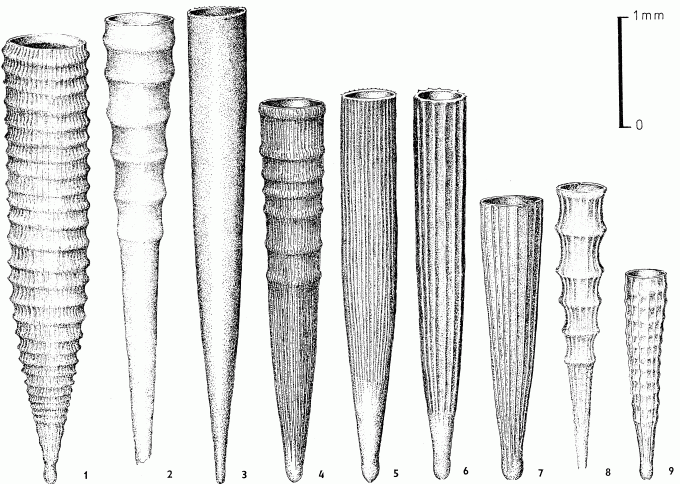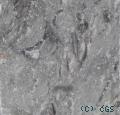Tentaculites (Tentaculitoidea)
Tentaculites (class Tentaculitoidea) represent an extinct group of marine organisms of uncertain affinity, which by many authors is placed in the class Mollusca. There is not general agreement about the systematics of this group so far, generally we can speak about three orders within this class: Tentaculitida (some authors include here also Cornulitida, affiliated also to the tubicolous worms), Homoctenida, and Dacryoconarida. The representatives of the order Tentaculitida have narrow, conical shells of calcium carbonate reaching the size of 15-30 mm. Prominent transverse rings ornament the shell. The proximal part of the shell is characterized by the presence of septa. The stratigraphic distribution of the order Tentaculitida is from Ordovician to Upper Devonian. Dacryoconarid tentaculites formed minute, elongated, conical shells of calcium carbonate. Diagonal rings and longitudinal ribs very often ornament the surface of the shell. A typical and also diagnostic feature of this group is the presence of an embryonic chamber. The stratigraphic distribution of Dacryoconarids is limited to the Devonian (Lochkovian-Frasnian). Representatives of the order Homoctenida formed also small, elongated shells similar to the shells of dacryoconarid tentaculites, some differences, however, exist. Homoctenids differ by the character of the shell ornamentation (longitudinal ribs are very often missing, the transverse rings are more prominent and densely spaced) and the embryonic part has the character of a projection. The stratigraphic distribution of Homoctenids is also limited to the Devonian (Lochkovian-Famennian).
Representatives of the order Tentaculitida are regarded as benthic organisms that inhabited shallow-water, relatively dynamic environments. Some authors suggested also a nectobenthic and semi-infaunal mode of life for this group. Dacryoconarids and Homoctenids, on the other hand, were planktic organisms – judging from their small size and widespread occurrence.
Dacryoconarid tentaculites represent one of the most important groups of the Devonian zooplankton. They form a basis for regional and global biostratigraphic correlations, which means that we are able to determine the relative age of the sedimentary rocks based on the occurrence of particular dacryoconarid taxa.
In the Barrandian area dacryoconarid tentaculites are almost exclusively present. The most common genera are Nowakia, Styliolina and Viriatellina.
In the Virtual Museum there are total 552 samples | |||||||
Virtual museum of the Czech Geological Survey, www.geology.cz, (C) Czech Geological Survey, 2011, v.0.99 [13.12.2011]


![[ENG]](img/vlajka-cr.gif) Česky
Česky 




